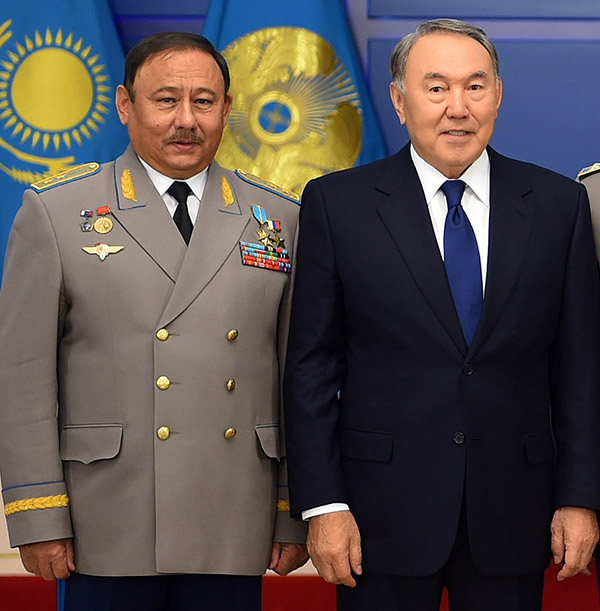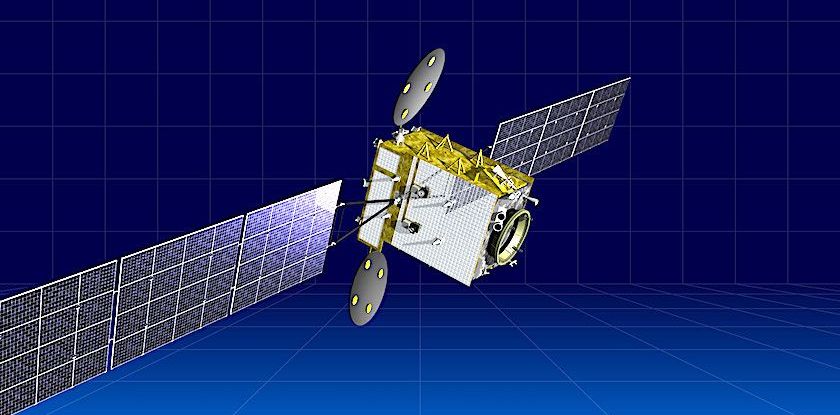The task of choosing a supplier for Kazakhstan’s new communication satellite will be carried out with the participation of Airbus Defence and Space that is the monopolist satellite producer on the Kazakh market. What’s behind this decision?
Already this year, Kazakhstan may acquire a new communication satellite (or not as it has so often been the case for the much-suffering space program of Kazakhstan). The funds for this undertaking have already been allocated from the state budget. The expenses related to the designing, creating and conducting of the ground tests are going to amount to 39.65 bln tenge (or 91.6 $ mln as of the decision-making moment).
These funds, according to Russia’s TASS information agency, are coveted by the producers from several countries — Russia, France, Italy, USA and Turkey. All of them have already sent their technical suggestions related to the building of the new Kazakh satellite.
Of course, it is unclear to whom these suggestions have been sent, however, one may assume that they will end up on the table of the top-managers of Ghalam LLP, the operator of Kazakhstan’s assembly and testing complex of space satellites in which the shares of the participants are divided in the following way.
- 72% of the shares belong to Kazakhstan Gharysh Sapary NC,
- another 0,5% belongs to the Aerospace Committee of the MDDIAI of the Republic of Kazakhstan, an organisational heir of the National Space Agency that, from 2007 to 2014, state-managed Kazakhstan’s entire space program,
- the remaining 27,5% of Ghalam belongs to Airbus Defence and Space, one of the Airbus Group’s subdivision.
Despite the overwhelming predominance of the Kazakh votes in the Ghalam capital stock, this company is Airbus’ enterprise from the technological standpoint. Thus, the choice of suppliers for the Kazakh satellite is going to to be done by the firm that is competing with them on the space services market.
And this is not coincidental. Our insiders have been talking about it for a long time now forecasting a definite victory of the Airbus holding in the future tender.
Now the future is becoming the present right in front of our eyes.
Starting from 2009, the entire ecosystem of the Kazakh business has been forming as an orbit around the Sun whose role has been performed by the European aerospace concern.
This story began after Kazakhstan Gharysh Sapary NC (aka Kazkosmos) had made a deal with the Astrium corporation (the European Aerospace and Defence’ subsidiary better known for its English abbreviation EADS; today it’s the Airbus Group) to found a joint-stock company.
According to the terms of the deal, EADS was responsible for the supply of the equipment and technologies necessary for the building of the assembly and testing complex for space satellites in Astana as well as for the preparation of more than a hundred of the Kazakh specialists capable of operating this equipment. Kazakhstan paid for all these services.
Apart from that, Astrium was ordered to produce two remote sensing satellites that Kazakhstan was planning to use for selling the services both inside the country and to other Central Asian states as well.
Thus, with one stroke of a pen, EADS had turned into the systemically-important operator of the Kazakh satellite complex. This story is remarkably reminiscent of the business practices of the Soviet times when the USSR used to make deals with Western concerns accepting their technological monopoly in exchange for support of the Soviet initiatives in the West and agreeing to make financial transactions to the benefit of the Soviet Union.
EADS, the world’s second aerospace concern size-wise (after Boeing), of course, possessed all the necessary qualifications to build the satellite industry in Kazakhstan, however, it did not mean that the company had to become the monopolist on the national market.
The signing of this agreement became possible after the resounding failure that marked the end of Kazakhstan’s first attempt to «go into space» and launch its own Sputnik.
Let us remind you that, on June 18, 2006, KazSat-1, a light telecommunications and geostationary earth-orbiting satellite, was launched into space with a huge political hype. It was designed and assembled by a Russian enterprise Khrunichev Space Research and Production Space Centre with the use of the inventions and components of 15 Russian and foreign firms that included all the international «grandes» — Boeing, Alcatel Alenia Spazio Italia, ComDev. However, this did not save the satellite.
Despite the promises of the producers that Kaz-Sat-1 would orbiting for more than 10 years, the malfunctions of the satellite’s control system started immediately after its launch, and, in November 2008, an irreversible failure happened — the control engines shut down. After all these misfortunes, in August 2009, they decided to move KazSat-1 to the disposal orbit.
The private companies that, under the «soft pressure» of Akorda, had switched their communications channels into it had suffered. The commercial usage of the satellite, by the time of its disposal, constituted about 70%. Kazakhstan’s aerospace plans had suffered a serious blow. The trust had been lost.
«It is the incompetent people that are engaged in the space industry in Kazakhstan», such was the verdict pronounced to his predecessors by astronaut Talgat Musabayev who, in 2007, accepted the Kazakh citizenship and became the head of the National Space Agency of the Republic of Kazakhstan created especially for him.

Kazakhstan’s entire space program got concentrated in Musabayev’s hands. The competing projects had been eliminated. They placed their bets on the skills and reputation of a single person. As for Musabayev, he placed his bet on EADS that, thanks to the astronauts efforts, became the main driver of Kazakhstan’s aerospace program.
This manifested itself clearly during the preparations of the launch of the new satellite KazSat-2 that was to demonstrate the successes of the Kazakh space program and the efficiency of its new leader. Under the pressure from Musabayev, they decided to replace the KazSat-2 control panel made by a Russian producer with the alternatives produced by EADS — Astrium. For this purpose, they had to postpone the launch of the satellite for more than half a year — instead of December 2010, it was launched in July 2011.
The fact that the ex-astronaut was driven not just by his sincere love for the French but by some more heavy-footed feelings became known later. In November 2017, French investigative online-media Mediapart published a material on how the French law-enforcement agencies’ investigation of the sale of the two satellites to Kazakhstan by EADS found the traces of a «mysterious payment» made from the Group’s accounts to the account of an offshore company whose ownership allegedly remained undisclosed even to EADS.
Those who wish to learn more on the subject may read the following Mediapart.fr material — Le gigantesque scandale de corruption qui menace Airbus (payment for access required).

To work with Kazakh «astronauts», they used the Paris office of the company officially called «Organisation of Sales and Marketing». It is believed that one of its top-managers Jean-Pierre Talamoni had paid the Kazakh representatives about 12 $ mln.
And Kazakhstan was not the only one. As a result of the investigation started in 2016 by the law-enforcement agencies of several countries, they have managed to uncover a system of kickbacks that had existed from 2011 to 2015 (the peak of the EADS/Kazakh relationships). The system was supposed to «stimulate» the buyers from among the officials representing the UAE, China, South Korea, India, Taiwan, Russia, Saudi Arabia, Vietnam, Japan, Turkey, Mexico, Brazil, Thailand, Kuwait and Columbia.
The commercial mechanisms actively used to promote technologies allows EADS to improve its financial standing and climb out of the hole in which the company found itself in the mid-2000s due to the delay of the manufacturing of A350 and A380. Back then, the company’s shares plummeted and EADS was rescued by Russian VTB that bought 5,02% of the EADS shares for approximately a billion euros hoping to engage EADS in the modernisation of the Russian aviation industry. However, the technological integration did not happen and the investment, from the financial standpoint, yielded mixed results.
Kazakhstan did manage the integration, however, it can hardly be called successful. It resulted in turning the country into a market outlet for the EADS space technologies that, as it happens, turned out to be not very modern and were clearly not worth the money spent on them.
Such is the consensus among the people familiar with the subject of Kazkosmos/EADS (Airbus) relationship.
«The earth remote sensing satellites were put in operation in 2015. These obsolete satellites were bought for a world of money, today a high resolution satellite (adjusted for depreciation) costs about 40 bln tenge while a medium resolution satellite costs 10 bln tenge. Considering that these satellites do not generate any profit for the company and the state due to the absence of an adequate marketing policy as well as existence of the indisputably stupid top-manages at the key official positions, their insurance costs to the budget about 1 bln tenge a year and their technical maintenance by the Airbus company costs about another 400 mln tenge a year. So you do the math on how much we pay for the space sector annually».
KazSat-2 that is orbiting and operating only 30% of its capacity so there is no question of this project being profitable. In general, however, it seems that the project of building the strategic relations between Kazakhstan and Airbus has turned out to be quite a profitable one. For an unidentified but quite a narrow circle of people.





